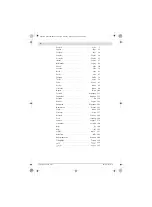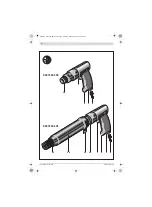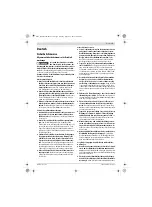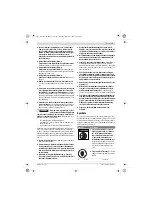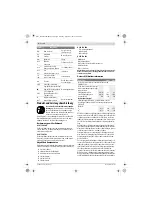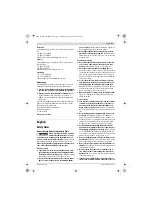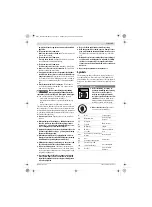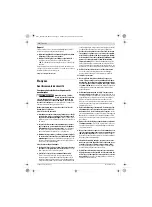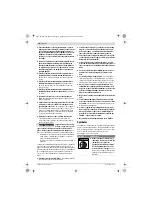
English |
15
Bosch Power Tools
1 609 92A 37P | (22.8.16)
Technical Data
Assembly
Connecting the Air Supply (see figure A)
Ensure that the air pressure is not lower than 6.3 bar
(91 psi) because the pneumatic tool is designed for
this operating pressure.
For maximum performance, the values for the inner hose di-
ameter as well as the connection threads must be adhered to
as listed in the “Technical Data” Table. To maintain the full
performance, only use hoses with a maximum length of 4 m.
The compressed air supplied should be free of foreign materi-
al and moisture to protect the tool from damage, contamina-
tion, and the formation of rust.
Note:
The use of a compressed-air maintenance unit is neces-
sary. This ensures proper function of the pneumatic tools.
Observe the operating instructions of the maintenance unit.
All fittings, connecting lines and hoses must be dimensioned
for the pressure and the required air volume.
Avoid restrictions in the air supply, e.g., from pinching, kink-
ing, or stretching!
When in doubt, check the pressure at the air inlet with a pres-
sure gauge with the pneumatic tool switched on.
Connecting the Air Supply to the Pneumatic Tool
– Screw hose fitting
4
into the connection socket at air inlet
3
.
To avoid damage to interior valve components of the pneu-
matic tool when screwing hose fitting
4
in or out, it is recom-
mended to counter-hold the projecting connection socket
of air intake
3
with an open-end wrench (size 22 mm).
– Loosen hose clamp
5
of supply-air hose
6
, mount the sup-
ply-air hose to hose fitting
4
and retighten the hose clamp.
Note:
Always mount the supply-air hose to the pneumatic tool
first, then to the maintenance unit.
Mounting application tools
Inserting a Chisel (0 607 560 500) (see figure B)
– Screw retaining spring
8
to the stop onto tool holder
7
.
– Bend hook clip
9
of retaining spring
8
open and insert a
chisel until the shoulder of the chisel is positioned behind
the hook clip.
– Release the hook clip
9
.
This secures the chisel against falling out.
Changing Needles (0 607 560 502) (see figure C)
– Loosen the pan head screws
12
.
– Pull guide sleeve
11
completely away from the needles.
This relieves the spring pressure on the apertured disc
14
.
– Remove the apertured disc
14
together with the needles
from the needle holder
13
.
– Push the needles out toward the rear and replace them.
– Assemble/mount all components again, tighten all pan
head screws and lock them with their lock nuts.
Operation
Starting Operation
The pneumatic tool works optimally at a working pressure of
6.3 bar (91 psi), measured at the air inlet when the pneumat-
ic tool is switched on.
Starting and Stopping
To save energy, only switch the power tool on when using it.
– To
switch on
the pneumatic tool, press the On/Off switch
1
and keep it pressed during the working procedure.
– To
switch off
the pneumatic tool, release the On/Off
switch
1
.
Working Advice
Sudden loads cause a sharp drop in speed or a complete stop,
yet do not cause damage to the motor.
When working, prevent idle running of the pneumatic tool.
Always press the chisel or needles firmly against the work-
piece.
Readjusting Needles (0 607 560 502)
– Loosen the pan head screws
12
.
– Slide guide sleeve
11
a little further onto needle holder
13
.
– Tighten all pan head screws and lock them with their lock
nuts.
Pneumatic chisel hammer Pneumatic needle descaler
Article number
0 607 560 500
0 607 560 502
Impact rate
min
-1
3600
3600
Tool holder
– Round shank
– Hexagon
mm
mm
10.2
10
–
–
Max. working pressure for tool
bar
psi
6.3
91
6.3
91
Thread size of hose connection
G 1/4"
G 1/4"
Inner diameter of hose
mm
10
10
Air consumption at no-load
l/s
cfm
8.5
18
8.5
18
Weight according to EPTA-Procedure 01:2014
kg
lbs
1.0
2.2
2.0
4.4
OBJ_BUCH-1568-005.book Page 15 Monday, August 22, 2016 10:54 AM


